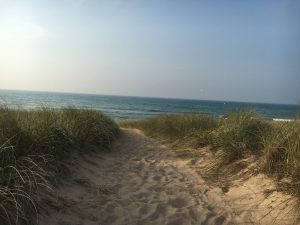Arriving to the shores of Lake Michigan, I sat for a moment in grateful silence. The sun felt strong, although it was already fall, and I shifted by body into its warm rays while listening to the waves hit the shore. Seagulls ducked and dove above, screeching warnings to one another. It wasn’t the ocean, but it sure felt like it.
Closing my car door and locking it with a cheerful beep, I walked towards the sand, throwing off my flip flops with glee. Sand between my toes, I walked slowly through one of the most remarkable areas in North America.
The shores of Lake Michigan boast the largest collection of freshwater dunes in the world. Quickly, I found myself walking beneath massive mounds of yellow sand, covered with a light fur of green dune grass. The air was filled with nervous-looking seagulls.
The birds eyed me with suspicion, but I meant them no harm.
Even just 16,000 years ago, Michigan was a sea of glacial ice rising thousands of feet high. Overtime, the ice had collected a mix of boulders, large stones, grains of sand, and clay. As the ice age waned and the glaciers melted, this deposit (glacial drift) was left behind. Slowly, the waves and currents of the great Lake Michigan moved the hardest, smallest sand grains inland, building up huge beaches along the shoreline. The wind, which can hit the coast at speeds around 8 to 25 miles an hour has taken over from there, slowly building up towering mounds sloping upwards from the water.
Although stunningly beautiful, these beaches and dunes are difficult places to live. Low in nutrients and subjected to pounding waves, wind, and winter ice and snow, few plants and animals have the fortitude to make their home here. I saw many small flies and beetles, plenty of seagulls, and even a few herring gulls.
The most amazing creatures here however, are the marram and sand reed grass. They are the first plants to establish themselves, fighting the shifting sand and, if successful, slowly providing a stabilized area for other plants to move in. Marram grass and sand reed grass both have extensive root systems, increasing the soil’s capacity to hold on to and store water and essential nutrients. The central stem of these grasses continues to grow as well, keeping the plant above rising sand. They are fighters from the beginning to the end.
As marram and sand reed grass begin to colonize an area, wildflowers and shrubs can begin to move in. Given time, areas that were once barren sand can be transformed by clusters of yellow hairy puccoon, milkweed (attracting gorgeous monarch butterlies), beach pea, sand cresss, bearberry, and wild grape. As long as humans respect these areas, foredunes can be stabilized essentially permanently, providing steadily blossoming habitat for other species.
As I walked down the beach, I felt mesmerized by the shining blue of the lake, a great reflective bowl mirroring the sky above it.
The sand was warm beneath my feet, and I ran my hand over the soft stems of the dune grass. It’s one thing to read about a place, it’s another to experience it, to walk along its spine.
I walked for almost two hours before returning to my car, feeling rejuvenated. As I finally reached for the door of my mechanical beast, I hesitated, wishing for a moment that I could stay out in the kind of world where life is so obviously in a state of constant change and fluidity…a world that shifts and moves with such grace. What lucky creatures we are, to live in a world of such amazing diversity and wonder. I am forever thankful to this year of travel for opening my eyes. I can’t wait to be back.




